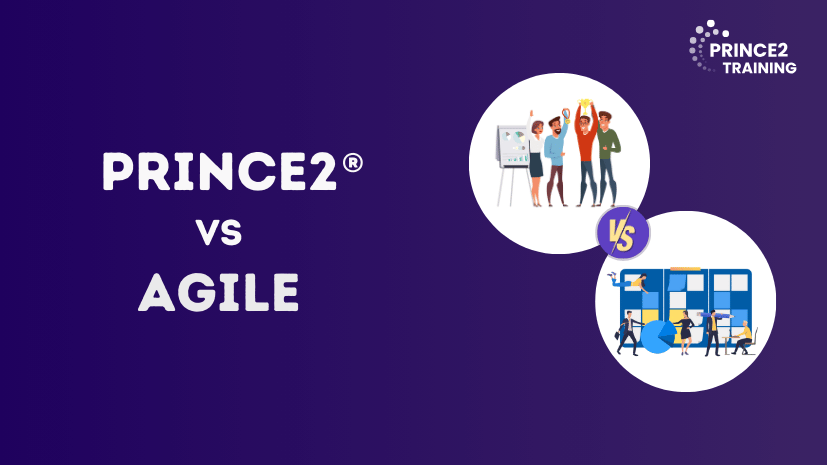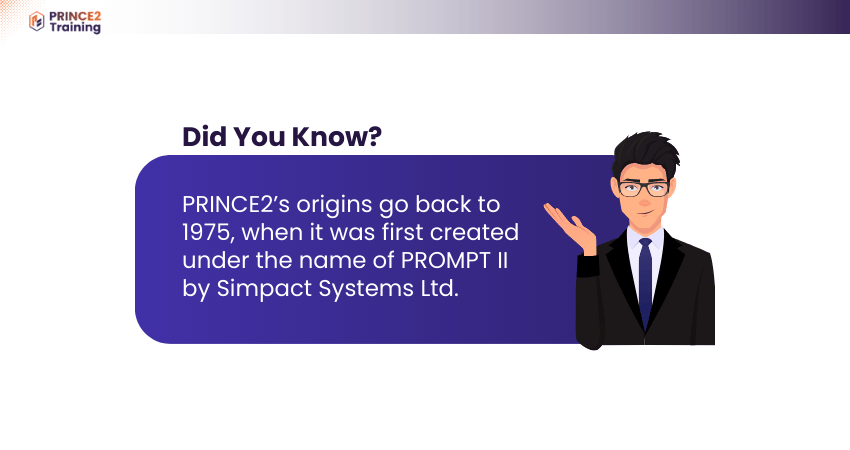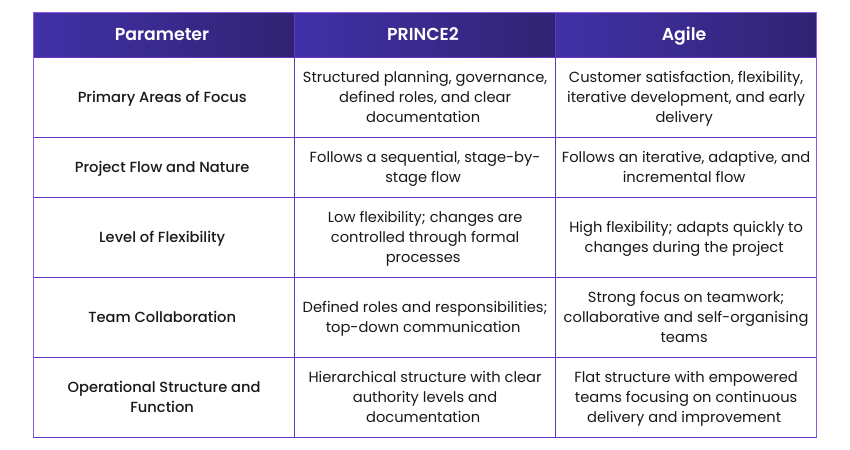Table of Contents

In Project Management, one size rarely fits all. The dilemma of picking between PRINCE2 Vs Agile is about finding the right rhythm for your project's journey. While PRINCE2 offers a structured blueprint, Agile delivers the advantage of flexibility, making it ideal for fast-changing needs. In the end, each method brings its own strengths, challenges, and style to the table.
This blog explores the key differences between these two prominent Project Management methodologies, outlining everything from their primary areas of focus and project flow to principles and level of flexibility. So read on and find the perfect fit for your next project adventure!
Table of Contents
1) Overview of PRINCE2 and Agile
2) What is PRINCE2?
3) What is Agile?
4) Key Differences Between PRINCE2 vs Agile
5) Comparing the Use of PRINCE2 and Agile
6) Conclusion
Overview of PRINCE2 and Agile
PRINCE2 is a popular project management method that focuses on careful planning, clear roles, and working through projects step-by-step. Agile takes a different approach by being flexible, moving forward in small steps, and encouraging teams to adapt quickly when things change. PRINCE2 is best for projects with clear goals, while Agile works well in fast-changing situations.
These two methods can also be combined. Using PRINCE2 and Agile together creates a balanced way to manage projects. PRINCE2 gives strong structure and leadership, while Agile keeps teams flexible and open to improvement. This mix is beneficial for complex projects, offering both control and adaptability.
What is PRINCE2?
Projects IN Controlled Environments (PRINCE2) is a Project Management methodology widely used across the UK and internationally. It's about clear roles, detailed planning and control stages that helps Managers make sure that the projects are delivered on time, within budget and with high quality.

PRINCE2 follows these seven principles:
1) Learn from Experience: Always use lessons from past projects to help improve future ones.
2) Continuous Business Justification: Make sure the project continues to support business goals from start to finish.
3) Defined Roles and Responsibilities: Set out who is responsible for what in the project as clearly as possible.
4) Manage by Exception: Set limits for each project goal so management only intervenes when things go wrong.
4) Manage by Stages: Break the project into smaller stages for easier control and better tracking.
5) Focus on Products: Deliver products that meet the quality standards that were agreed upon at the start.
6) Tailor to Suit the Project: Adjust the PRINCE2 method to fit each project's specific needs and situation.
What is Agile?
Agile is a prominent methodology for Project Management and software development focusing on flexibility, collaboration and iterative progress. It's designed to adapt to changing requirements and deliver value incrementally. The core principles of Agile are as follows:
1) Working Software: You should focus on delivering functional software rather than a bunch of documentation.
2) Customer Collaboration: You must engage the customers throughout the development process to make sure their needs are met in a timely manner.
3) Individuals and Interactions: You must prioritise people and their interactions over processes and tools.
4) Responding to Change: You should embrace any sudden changes in requirements, even late in development, to improve the product's value.
Additionally, Agile methodologies often incorporate practices such as:
1) Iterative Development: You should break projects into small, manageable iterations or sprints.
2) Continuous Feedback: To refine and improve the product, it’s important to regularly gather stakeholder feedback.
3) Cross-functional Teams: You must encourage collaboration amongst team members with different skills and expertise.
4) Adaptive Planning: You will have to adjust plans based on evolving project needs and priorities.
Make sure every detail of your next project is perfect! Our PRINCE2 Agile® Practitioner Training will show you how to accomplish that – Sign up now!
Key Differences Between PRINCE2 vs Agile

Comparing the Use of PRINCE2 and Agile
Despite their common goal being Project Management excellence, there are key differences in how PRINCE2 and Agile are used. Let’s explore them in detail:
Method vs Philosophy
1) PRINCE2: It's a structured Project Management methodology with defined processes, roles, and responsibilities. It provides a step-by-step guide to managing projects from start to finish.
2) Agile: It’s a philosophy that spotlights flexibility, collaboration and customer feedback. It encourages teams to evolve their approach based on real-time needs.
Prescriptive vs Adaptable
1) PRINCE2: It's highly prescriptive as it outlines specific steps and documentation requirements. It helps you ensure that projects are tightly controlled and aligned with organisational goals.
2) Agile: It enables teams to tailor their processes based on project needs. Teams boast the freedom to adjust their workflows as challenges arise.
Traditional vs Innovative
1) PRINCE2: This is a traditional approach that's suitable for projects with well-defined scopes. It works best in industries where clear, upfront planning is critical to success.
2) Agile: It's an innovative approach which is ideal for projects requiring quick changes and continuous improvement. It supports industries that thrive on creativity, speed and customer feedback.
Your mastery of the seven principles, themes and processes of PRINCE2 awaits! Sign up for our PRINCE2® Foundation Training now!
Waterfall vs Iterative and Agile
1) PRINCE2: It follows a waterfall model with sequential phases. Each stage must be completed before the next one can begin, allowing for structured reviews.
2) Agile: Employs an iterative approach, delivering work in short cycles or sprints. This helps quickly adjust priorities and improve products with every iteration.
Formal vs Informal
1) PRINCE2: Emphasises formal structures, roles and documentation. Clear responsibilities and reporting lines make it suitable for larger organisations.
2) Agile: Leans towards an informal setup, focusing on collaboration and adaptability. Team members often take shared ownership without rigid role boundaries.
Top-down vs Bottom-up
1) PRINCE2: It adopts a top-down management style, with decisions flowing from leadership. Project Managers hold strong authority to make sure the processes stay on track.
2) Agile: It encourages a bottom-up approach that empowers teams to make decisions. Teams are trusted to find the best solutions and manage their own progress.
Documentation vs Working Software
1) PRINCE2: It prioritises detailed documentation to drive project execution. These records serve as proof of progress, quality control and accountability.
2) Agile: This approach focuses on delivering working software and values it over extensive documentation. The goal is to deliver a usable product early and continuously improve it.
Conclusion
In essence, when it comes to PRINCE2 vs Agile, there’s no one-size-fits-all answer. It’s about matching the method to your project’s heartbeat; steady and structured, or fast and flexible. Know your environment, trust your judgement, and you’ll steer any project towards success with skill and confidence.
Planning, executing and managing projects doesn’t have to be an uphill battle! Our PRINCE2® Certification will show you how – Sign up now!




 Back
Back


 Back to
topics
Back to
topics









